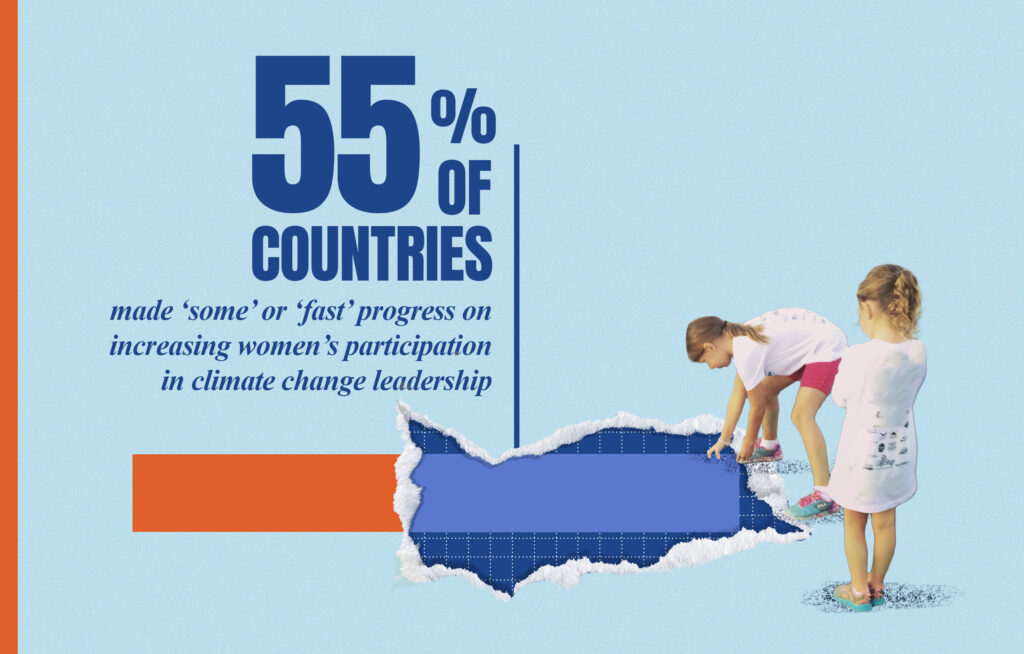If representation is a rights issue, why are women still critically underrepresented?
By Maxine Betteridge-Moes
“Leadership is a means, not an end,” wrote the feminist activist Srilatha Batliwala, an India-based scholar with the Association for Women’s Rights in Development. With this statement in mind, and in order to make sustainable progress on gender equality by 2030, we must not only fix the system that holds women back from positions of power and authority, but also ensure that women that do arrive to these leadership positions can hold onto their authority and exercise their power to achieve social transformation for generations to come.
The 2022 SDG Gender Index measures women’s leadership and representation across 14 of the 17 UN Sustainable Development Goals. Of the 56 indicators used to measure gender equality in the Index, four indicators directly measure aspects of women’s leadership, namely: women in parliament, women in ministerial posts, women in science and technology, and women in climate change leadership. In its second edition, the Index measures progress over time and has evolved into an even more useful tool for advocates to hold their governments to account in achieving gender equality.
Alison Holder, the director of Equal Measures 2030 says the Index shows that while some countries have made significant progress on women’s representation in recent years, a persistent lack of gender data masks disparities across different sectors and groups of women.
“If you dig into the Index, there is a mixed picture in terms of progress on women’s representation,” she said. “We have to celebrate progress where it’s happening, but there isn’t one single trend or story we can draw about women’s leadership from the Index.”
“It’s the system’s problem”
Women’s representation and feminist leadership are two important concepts for gender equality, but they are not one in the same. While women’s representation is easier to count and measure through data and statistics, feminist leadership considers how power is executed and decisions are made. As champions of grassroots feminist leadership themselves, many of EM2030’s partners have found ways to redefine, value, use, share and distribute power.
“One of the challenges is that the focus is usually on fixing the woman rather than fixing the problem,” explained Emily Maranga, the program manager at GROOTS Kenya. “So we use the power of our collective to carry out advocacy and encourage women to take up leadership. Because if the leadership spaces are open and women are not taking them up, that’s not the woman’s problem. It’s the system’s problem.”
The volatility of women’s leadership
The best available data in terms of measuring women’s leadership is their political representation in parliament and senior government roles. According to the Index, the world on average made significant progress on women’s political representation between 2015 and 2020: 90 countries made ‘very fast’ progress on increasing women’s representation in parliament and 78 countries made ‘very fast’ progress on increasing women’s representation in senior government roles.
“We can’t ignore, however, that this progress comes from a very low base and the world is still far from where it needs to be to meet the target of gender parity in political participation,” said Holder. In 2020, just 26.4% of parliamentary seats and 24.7% of senior government roles globally were held by women. The volatility of these statistics also can’t be ignored, as women’s representation can fluctuate widely depending on the political agenda of ruling parties. For example, the Index shows that between 2015 and 2020, several countries including Ethiopia, Lebanon and Mexico saw major leaps forward in the percentage of women in senior government positions, while several countries including Estonia, Slovenia and Poland fell back significantly in the wrong direction. The result is an overall global grade of ‘very poor’ for these two indicators.

Other indicators on women in science and technology and on women in climate change delegations paint an even more mixed picture. As of 2018, only 31% of science and technology research posts were held by women, and on average, the world had made ‘no progress’ on increasing the share of women since 2015. In terms of women’s representation in climate change delegations, Holder describes a “tale of two halves”. While 55% of countries made ‘some’ or ‘fast’ progress on increasing women’s participation in climate change leadership between 2015 and 2020, a large proportion of countries (41%) moved in the wrong direction on this measure and reduced the proportion of women in their climate change delegations. At COP26 in Glasgow in 2021, the global summit to accelerate action on climate change, women accounted for, on average, 33% of government delegates, just as they did in 2019 and 2020.
Persistent data gaps
The increased participation and presence of women in politics and public life is a vital step towards advancing gender equality – but it is not the only factor. Women often encounter hierarchical and exclusionary power structures in decision-making spaces that undermine their active participation and engagement. Transforming this structural context is key for their political empowerment and authority.
Data on women’s representation in parliament and senior government positions is relatively easy to find, but it indicates that women in these formal political spaces come from more privileged backgrounds. Comparable data on women’s representation at the subnational level is scarce, and for nearly half of all countries, sub-national data does not exist at all. Most countries do not collect data on women’s representation in the private sector and in NGOs, which is needed to provide a clearer picture of women’s voice and influence across sectors. Data is also missing across all sectors on the participation and experience of other groups including ethnic or racial minorities, the LGBTQ community, women with disabilities and others, to arrive in leadership positions.
“The Index report expresses the importance of having better gender data that allows us to measure intersecting inequalities to look at the situation for women on average, but crucially the situation for different groups of women to ensure equality and justice,” said Holder.
The road ahead
Even as most countries worldwide seem to be making some advances on women’s representation, the SDG Gender Index sounds the alarm at its slow pace, its limited scale, and its profound fragility. It’s still too soon to gauge the full impact of the COVID-19 pandemic on girls and women around the world, and future humanitarian crises will further expose and intensify the severe inequalities laid bare in the Index. What matters now is what we do next.
The first step for women’s rights advocates like EM2030 is to continue promoting the visibility of female politicians and decision-makers across public and private sectors, and collecting and using disaggregated data to plug persistent gaps around women’s leadership and representation. Donors must invest more in data monitoring and accountability across all sectors, fund grassroots organizations and invest in more training programs on political systems, women’s right to participation, and their roles in decision-making. Finally, governments can promote quota systems to help bring women into political spheres, use international frameworks to bring diverse women into emergency responses, conflict prevention, and peacebuilding, invest in structural and legal reforms that provide women with social and legal protections, and finally, call for gender-balanced decision-making bodies.
The road ahead for gender equality, and particularly for women’s representation and feminist leadership will undoubtedly have its bumps. But as Lina Abirafeh, the former Executive Director of the Arab Institute for Women puts it: “Right now, we need to defend and reclaim our space, our voice and our words. And then we can move forward.”



